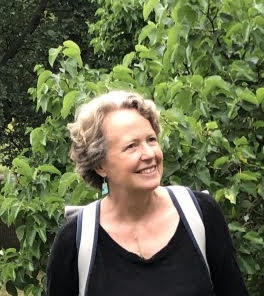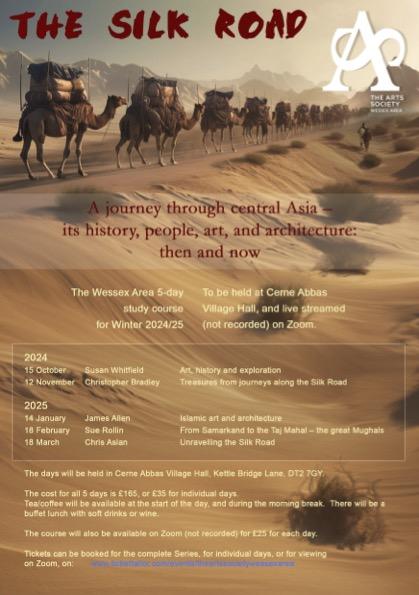Join us on this magical journey on The Silk Road - 5 day study series to be held in Cerne Abbas Village Hall, DT2 7GY and online.
Day 1 on 15th October 2025 with lecturer Dr. Susan Whitfield
The Silk Road - Art, History and Exploration
10:30 am Introduction to its History and Cultures. A general context-setting lecture, illustrated with maps and artefacts, giving an outline of what we mean by the Silk Road and introducing some of the major events and cultures along it in the first millennium AD.
11:30 - 12:00 - Coffee break
12:00 - 13:00 Exploration and Discovery. This tells the story of the early 20th imperial archaeologists of the Silk Road, concentrating on the British/Hungarian, Sir Aurel Stein, and how he uncovered forgotten civilisations of the Silk Road from the desert sands of the Taklamakan. His finds are now mainly in the British Museum and British Library.
13:00 - 14:00. Lunch
14:00 - 15:00 Art. This lecture introduces several wonderful pieces of art exemplifying the transmissions and interactions of peoples, faiths, technologies, materials and designs along the Silk Road. The objects include a gilt silver flask, a glass bowl, and a patterned sil.
Day 2 on 12th November 2024 with lecturer Christopher Bradley
Treasures from journeys along the Silk Road
The Silk Road extends over 8,000 kms from China through Central Asia to the Mediterranean. The route acted as a highway for beliefs, ideas, inventions and art, whilst silk was just one of the many valuable commodities traded for 1,400 years. With the Greek invasion of Alexander the Great, early Persian routes spread east towards India. Chinese stability finally allowed the trade of silk, jade and ceramics in exchange for horses, pearls and gold. The wonderful paintings in the Magao caves at Dunhuang are evidence of the spread of Buddhism along the Silk Road. Samarkand and Bukhara are the beginning of the great Islamic buildings that continue through Persia and Syria. Along the way we will see traditional murals, ceramics, statues, carpets, architecture, tile-work and of course silk itself.
Day 3 on 14th January 2025 with lecturer James Allen
Islamic Art and Architecture
10:30 - 11:30 Arabic calligraphy. The destruction wrought by Muslim fundamentalists is only one side of Islam, and Islamic art is outstanding for its serenity, its elegance, and its beauty. Lectures 1 and 2 introduce Islamic art through its three most widely appreciated strands. In the first lecture we shall look at the art of Arabic calligraphy, the supreme art of the Islamic world. Don’t worry, you do not have to know Arabic to enjoy it and appreciate its beauty! The lecture will teach the basic elements of the Arabic script and illustrate many of the styles of calligraphy which developed in different parts of the Islamic world. It will also draw attention to the role of Arabic calligraphy in Middle Eastern politics today.
11:30 - 12:00 Coffee break
12:00 - 13:00. Geometry, the Arabesque and Figural Art, looking at geometry and the arabesque, following the latter into the range of floral designs current in later Islamic art. We shall see too how geometry and the arabesque combine to make highly intricate, but deeply satisfying, designs in a range of media. There is another element to Islamic art, however, figural art. It is mistakenly believed, both by Muslims and non-Muslims, that Islamic art is non-representational. We shall explore Islamic art’s figural side, and show how widespread figural art really is, even, most surprisingly, in some religious settings, highlighting sectarian divides in the Islamic world.
13:00 - 14:00 - Lunch
14:00 - 15:00 Domes and Minarets: Mosques of the Islamic world. Images of Romanesque or Gothic cathedral architecture may linger in our memories, but many of us would be pressed to describe a typical mosque. We shall look at three of the most important forms, typified by the Friday Mosque in Cordova (now the Cathedral), the Mosque of Suleyman the Magnificent in Istanbul, and the Royal Mosque in Isfahan. The lecture explores their different styles, and the minarets and domes that enhance their skylines, and illustrates the rich designs, whether in mosaic, tile, or other media, that adorn these buildings. It also asks whether sectarian differences between Sunni and Shia belief affect mosque design.
Day 4 on 18th February 2025 with lecturer Sue Rollin
From Samarkand to the Taj Mahal – Central Asia and the great Mughals
10:30 - 15:00 (Lunch break 13:00 - 14:00) Under the great conqueror Tamerlaine and his successors Central Asia experienced a Golden Age. Samarkand and other cities were endowed with splendid monuments, art, literature and science flourished. Babur, the last of the Timurids, expelled from his homeland, went on to conquer India and found the Mughal empire. There the Mughal emperors presided over magnificent royal courts and sponsored creative building which reached its apogee in the Taj Mahal.
Day 5 on 18th March 2025 with lecturer Chris Aslan
Unravelling the Silk Road
10:30 - 15:00 (13:00 - 14:00 lunch) Wool, cotton and silk have each played a crucial role in the fortunes of Central Asia. Wool created the clothing and housing needed by the great nomadic cultures that were to dominate Middle Asia. Silk was more valuable than gold and used as currency, creating a network of trading routes that led to the first outbreak of globalisation. Cotton was the cause of Russian and then Soviet Colonisation and continues to cause controversy today as well as human misery and environmental catastrophe The felts, carpets, embroideries, robes and veils of the Silk Road stratified wealth, displayed religious and political entrenchments and changed the fortunes of this fascinating part of the world; a meeting place between Mohammed and Marx.
Fee: 5 days @ £165 including tea/coffee and biscuits plus a light lunch with wine, coffee/tea or a soft drink.
The cost of the 5 Day ticket includes a reduction of £10 on the normal price of £175
Fee for 5 days online: £100
For all enquiries, please contact Christoper on wessexconnectedevents@gmail.com







